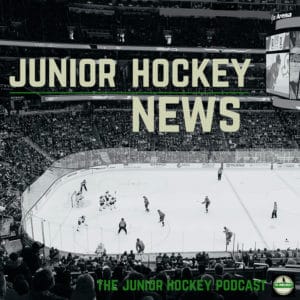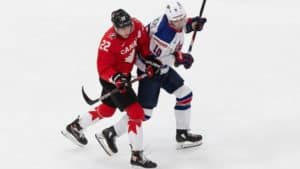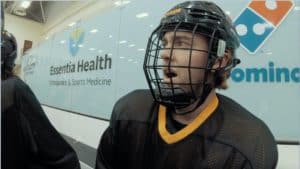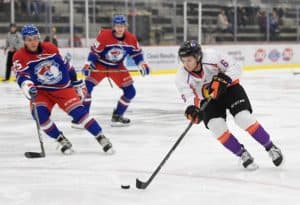TJHP upgraded its news platform this past summer to help counteract the way college-bound hockey is covered in the United States. Our commitment is to address issues (and rumors) the old-fashioned way — talk to the people involved and try to present facts rather than taking the easy path of jumping on the internet bandwagon.
This particular incident, which fired up the Rumor & Rhetoric Machine quickly, stopped just over the irresponsible side of a line that involved accusing a player of attempted murder and alleging a longtime WSHL franchise puts forth a culture of such barbaric proportion that the owner/head coach and the entire organization should be removed from the face of the hockey map. I’m not embellishing that overview.
Godwin’s Law
States the longer an internet discussions goes on, the higher the likelihood of comparing someone or something to Adolf Hitler or his deeds. In this case and other hockey situations it now takes fewer than 24 hours — with or without facts being used — for a similar effect to take place. This player, his coach and the entire organization was tried and convicted based upon social media reaction seemingly before the game was even complete.
Neither TJHP nor our competitors in the content business are actually involved on the inside of college-bound hockey. Although some of us actually used to be, we now just cover the sport. Some of us have verifiable resumes and experience that a quick Google search can prove, others don’t have any background other than running websites that provides platforms to make vague, personal claims about how influential they view themselves.
The notion that we can change the way an entire hockey league operates, or even a single organization, by circulating rumors and making empty threats is Ego Stroking 101 at its best. It also does nothing in terms of ensuring a story is told accurately. Jumping the gun is a gutless and sensationalist way to address any situation (as a side note, if you Google me you’ll have to sift through a few pages of a tall, handsome former USA Olympic volleyball player — that’s not me).
Before I continue, and deal with the accusations of being soft on hockey violence or anti-victim, I want to make something very clear: I’m so anti-violence in hockey that I think Fighting should go the way of the dinosaur at all levels of the sport. By saying that I realize I am immediately painted with the broad brush of being soft on hockey and helping to facilitate the demise of our great sport. There is an irony to being viewed as soft on violent hockey incidents and soft on “tough” hockey at the same time.
Getting rid of Fighting wouldn’t be difficult to do. Just make the penalties for Fighting so severe that it rarely happens. The National Hockey League did it with bench-clearing brawls more than 30 years ago and any league can do the same with fighting.
The last bench-clearing brawl in the NHL took place during the 1986-87 season after which the NHL, so determined to rid the sport of this type of brawling, imposed a rule that slapped a 10-game suspension and hefty fine for any player who left the bench for the purpose of engaging in a fight. End of problem. It has’t happened since because of a full commitment by all involved.
Whether Fighting should be allowed or not is not the purpose of this discussion, but the NHL proved anything can be legislated out of the game, including time-honored, “part of the sport” traditions. If the NHL can do it so can any other league.
I found much of Monday’s social media outrage so hypocritical that is was almost laughable. While ready to figuratively hang the player and organization involved in this incident, many said that this was different than Fighting because Fighting is part of the fabric of the game. They said a side headlock is not part of the game it’s part of MMA. Any parent, like me, who has seen his or her kid lying on the ground, out cold and fully concussed, couldn’t possibly think eating a big right hand as “just part of the game” is a good idea.
Losing consciousness from a headlock should be prosecuted by local law enforcement but pounding an opponent unconscious with a right or left hook is OK?
That’s my bigger point in all this. It’s all bad and should all be dealt with severely. Violence inside the game and out, incidents that make a travesty of the game, etc., are all bad as they detract from our sport. Any league that wants customers to consider playing for one of its organizations can publicize how firmly it deals with these incidents. Marketing the way it handles and publicizes disciplinary action would go a long way to dispelling rumors and quieting the internet Torch & Pitchfork Crowd.
League officials have a beautiful tool called “Supplementary Discipline” which allows them to discipline anyone involved in the game, or with a team, without having to fit the person’s conduct into a specific rulebook citation. I’m talking about stupid stuff that may happen in rink lobbies, locker rooms, in hallways between periods, at hotels, etc. There is an appeals process with any USA Hockey league so there is due process, but a league leader does not need to cite specific rules or referee reports when deciding whether to discipline someone for an act that doesn’t pass the smell test.
Anecdotally speaking, based upon my experiences and discussions with current and former on-ice officials and coaches, Junior hockey is the level with the most potential for big problems. Players are hormonally and maturity-challenged while playing an aggressive, hard-nosed game. Where they should draw the line with conduct is not always clear when adrenaline is pumping. How that conduct is addressed by team and league leaders should always be clear.
Getting back to the incident that sparked Monday’s internet free-for-fall: As it turns out the league reviewed the situation, based upon video and on-ice referees reports, and released the following text (see below). What is clear from the video is:
- The linesmen and referees were rightfully paying close attention to the situation in front of the benches to prevent an incident from becoming a really bad incident. There are 10 players on the ice and two linesmen. You take care of the biggest potential problem first.
- The incident in question took place literally at the feet of the linesmen (who were rightfully making sure none of the players milling about, and involved with other altercations, were allowed to spill into the bench area). For those who have never officiated during an actual or potential line brawl, the video shows how line brawls can erupt. I’m not sure this is a law of physics, but generally speaking any altercation that enters a bench area will return to the ice with more players involved. Or the converse can be true, any altercation that enters a bench area will be followed by yet more players entering said bench area. Two players lying on the ice engaged in a non-punching situation aren’t a priority in this situation.
- Clearly something happened to the Dallas player who left the ice. Based upon the result of the investigation there is no reason to believe the player did not lose consciousness as a result of his engagement with the El Paso player.
- There is no evidence to suggest that the player was choked or — as was alleged — murder was attempted.
- The league not only weighed in with a written statement, but with supplementary discipline in the form of a four-game suspension applied to the El Paso player. I challenge anyone to find a written discipline statement by another Junior league. I was not able to release this type of information while serving as the executive director of the Eastern Hockey League and as commissioner of the United States Premier Hockey League.
- The El Paso organization is also assessing an additional three-game suspension to its own player, which in my experience means El Paso and the league not only cooperated but agreed upon the course of action to take.
So the internet fire up again today, and those who have never officiated a game, or know the protocol for handling a potential line brawl situation in the bench area, can again call for the jobs of the on-ice officials. They can get back to the business of alleging an organization is good or bad, with no experience in dealing with that organization. And they can get back to alleging a league actually promotes violence and purposely sets up shop so 19-year-olds can get injured. And they can find the websites that promote that type of reaction.
Or they can consider a bad incident happened, a review took place, a league took action, a team took action and a decision was handed down and publicized all within 48 hours. Ron White, WSHL Commissioner answered my communication and did not duck my request as has been done by at least two other Junior leagues this year. It is hoped time will alleviate the reticence for coaches, team officials and league officials to speak about topics, both good and bad. TJHP has to continue to report facts, giving all sides a chance to comment, in order for the lines of communication to be fully open. There has been a lot of internet-based damage over the past few years that cannot be undone overnight.
This in no way justifies, defends or minimizes the incident in question, it just means it was handled swiftly and decisively. Where leagues take disciplinary action in the future is up to the owners and operators who create the rules by which they operate. If you are a potential customer of a team and league, and you are unsure of their ability to provide a safe and professional environment, by all means look in a different direction.
Incident report issued by Western States Hockey League:
The scrum starts with a chest high cross check by a El Paso player to a Dallas player who then throws two-three punches to the face of the El Paso player. The El Paso Player was without a helmet at the time of the punches. From there all ten players on the ice bunch up and #13 Dallas is one of the later players to join the pile. As he enters the pile he reaches over the back of a El Paso player to pull the El Paso player away from the scrum, unfortunately a late arriving El Paso player #23 grabs #13 in similar fashion by reaching over #13 back to pull him away.
Once he pulled him away, #23 then had #13 in a head lock and tried to throw him to the ice, but it took two attempts to do so. By the second attempt, the scrum had moved close to the dasher boards, and #13 was likely thrown onto the dasher board head first and went down to the ice.
At that point the scrum broke up. Dallas player #13 was on the down on the ice for 1.5 minutes, and then proceed to the locker room. It should be noted that Dallas player #13 returned to the game in the 3rd period as indicated by Dallas Head Coach Aaron Davis.
The game film was reviewed by the Disciplinary Committee, in addition to two WSHL Referee in Chiefs, along with interviews with Dallas Head Coach Aaron Davis, El Paso Head Coach Cory Herman. At no time on the film is #13 seen being choked by any El Paso player. The injury which fortunately was minor since #13 returned to the game as indicated by Dallas Head Coach.
In review of the scrum all 10 on ice members of the team were involved including #13 Dallas and #23 El Paso.
Minor penalties could have been handed out to all players on the ice including #13 who skated into the scurm (sic) late with the intent of joining the scrum. However #23 El Paso use poor judgement in grabbing #13 and trying to throw him to the ice. As mentioned, the first attempt did not succeed, and a second attempt was initiated with more force and vigorous attempt to put the player down. There was plenty of time for #23 to resist a second attempt as things were starting to calm.
Due to the second attempt, which was significantly more serious given the very close proximity to the dasher boards, #23 was issued after review by the Disciplinary Committee a “Match Penalty”. The Supplemental review has been issued as a four-game suspension.
In addition, the El Paso Rhino’s have increased that suspension by three more games, bringing the total to seven games suspension for El Paso #27 (23). Again it should be noted that Dallas #13, fortunately, was able to return to play in the game. In the opinion of the Committee, there was never any choking of the player or interference from the players on the bench to #13’s safe being.
Jeff Nygaard is the editor of The Junior Hockey Podcast. He covers Junior and college-bound hockey as a traditional “beat,” in addition to breaking news stories during the course of the year
He has a vast amount of experience on the business and organizational side of the sport as a former owner-operator of two Junior organizations two youth clubs and has served as executive director or commissioner of the Eastern Hockey League and the United States Premier Hockey League.
A Fergus Falls, Minn., native, Nygaard grew up playing for the Fergus Falls Youth Hockey Association, Fergus Falls High School, Fergus Falls Community College, and North Dakota State University programs. He can be reached at info@juniorhockeyhub.com for questions, story ideas, and anonymous tips.











